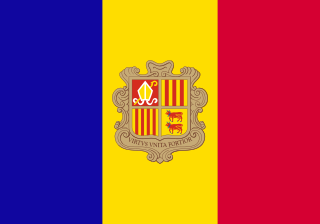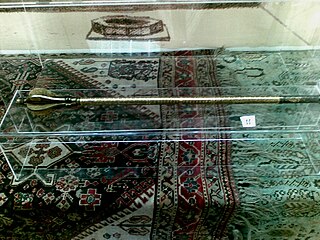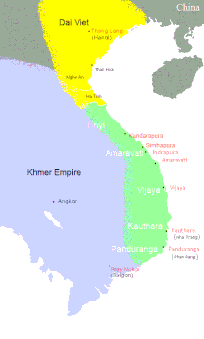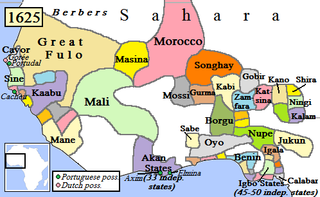Sovereign states
A
- Alipura – Alipura
- Algiers – Sultanate of Algiers
- Ahom – Ahom Kingdom
- Andorra – Principality of Andorra
- Angoche – Angoche Sultanate

- Arrakal – Arrakal

- Assam – Kingdom of Assam

Andorra, officially the Principality of Andorra, also called the Principality of the Valleys of Andorra, is a sovereign landlocked microstate on the Iberian Peninsula, in the eastern Pyrenees, bordering France to the north and Spain to the south. Believed to have been created by Charlemagne, Andorra was ruled by the Count of Urgell until 988, when it was transferred to the Roman Catholic Diocese of Urgell, and the present principality was formed by a charter in 1278. It is known as a principality as it is a diarchy headed by two Princes: the Catholic Bishop of Urgell in Catalonia, Spain, and the President of France.
The Angoche Sultanate was established in 1485 along an archipelago off the Northern Mozambique coastline. Centered on the cities of Angoche and Moma, the sultanate also had a number of vassal territories surrounding them. They were finally removed from power by the Portuguese colonial government in 1910.

Ankole, was a traditional Bantu kingdom in Uganda. The kingdom is located in south-western Uganda, east of Lake Edward. It was ruled by a monarch known as the Mugabe or Omugabe. The kingdom was formally abolished in 1967 by the government of President Milton Obote, and since then, the kingdom has not been restored officially. The people of Ankole are called Banyankole in Runyankole language, a Bantu language.
B
- Baku Khanate
- Bamana – Bamana Empire


- Bhutan – Kingdom of Bhutan
- Bukhara – Khanate of Bukhara
- Burma – Kingdom of Burma

Baku Khanate, was an autonomous Muslim principality under Iranian suzerainty, which existed between 1747 and 1806. Originally a province of Safavid empire, it became practically independent after the assassination of Nadir shah and weakening of central authority in Iran due to the struggle for power. Its territory now lies within present-day Azerbaijan,

The Bamana Empire was a large West African state based at Ségou, now in Mali. This state was established after the fall of the Mali Empire and the Keita dynasty, as a smaller Bambara Empire founded by other Bambara families related to the Keita clan. It was ruled by the Kulubali or Coulibaly dynasty established c. 1640 by Kaladian Coulibaly also known as Fa Sine or Biton-si-u. The empire existed as a centralized state from 1712 to the 1862 invasion of Toucouleur conqueror El Hadj Umar Tall.

Brunei, officially the Nation of Brunei, the Abode of Peace, is a country located on the north coast of the island of Borneo in Southeast Asia. Apart from its coastline with the South China Sea, the country is completely surrounded by the Malaysian state of Sarawak. It is separated into two parts by the Sarawak district of Limbang. Brunei is the only sovereign state completely on the island of Borneo; the remainder of the island's territory is divided between the nations of Malaysia and Indonesia. Brunei's population was 423,196 in 2016.
C
- Cayor – Kingdom of Cayor
- Champa
- China – Great Qing Empire



Cayor was the largest and most powerful kingdom (1549–1879) that split off from the Jolof Empire in what is now Senegal. Cayor was located in northern and central Senegal, southeast of Walo, west of the kingdom of Jolof, and north of Baol and the Kingdom of Sine.

Champa was a collection of independent Cham polities that extended across the coast of what is today central and southern Vietnam from approximately the 2nd century AD before being absorbed and annexed by Vietnamese Emperor Minh Mạng in AD 1832. The kingdom was known variously as nagara Campa in the Chamic and Cambodian inscriptions, Chăm Pa in Vietnamese and 占城 (Zhànchéng) in Chinese records.

The Republic of Cospaia was a small state within modern day Italy, located in northern Umbria, independent from 1440 to 1826. It was located in what is now the hamlet (frazione) of Cospaia in the comune of San Giustino in the Province of Perugia.
D
- Dendi – Dendi Kingdom




The Dendi Kingdom (1591–1901) was a West African state in modern-day Niger founded by the Dendi people after the collapse of the Songhai Empire. It was conquered by France in 1901.

Denmark–Norway, also known as the Dano–Norwegian Realm, the Oldenburg Monarchy or the Oldenburg realms, was an early modern multi-national and multi-lingual real union consisting of the Kingdom of Denmark, the Kingdom of Norway, the Duchy of Schleswig, and the Duchy of Holstein. The state also claimed sovereignty over two historical peoples: Wends and Goths. Denmark–Norway had several colonies, namely the Danish Gold Coast, the Nicobar Islands, Serampore, Tharangambadi, and the Danish West Indies.

Norway, officially the Kingdom of Norway, is a Nordic country in Northern Europe whose territory comprises the western and northernmost portion of the Scandinavian Peninsula; the remote island of Jan Mayen and the archipelago of Svalbard are also part of the Kingdom of Norway. The Antarctic Peter I Island and the sub-Antarctic Bouvet Island are dependent territories and thus not considered part of the kingdom. Norway also lays claim to a section of Antarctica known as Queen Maud Land.
E
- Ethiopia – Empire of Ethiopia
F

G
- Garo – Kingdom of Garo


The Kingdom of Garo, also known as Bosha after its ruling dynasty, was an ancient kingdom in the Horn of Africa. Established by the mecha oromo, it was situated on the periphery of the Gibe region. The garo oromo was named from the word (gaara) means "the upper site", the place where they were living at that time.

The Republic of Genoa was an independent state from 1005 to 1797 in Liguria on the northwestern Italian coast, incorporating Corsica from 1347 to 1768, and numerous other territories throughout the Mediterranean.

The Kingdom of Great Britain, officially called simply Great Britain, was a sovereign state in western Europe from 1 May 1707 to 31 December 1800. The state came into being following the Treaty of Union in 1706, ratified by the Acts of Union 1707, which united the kingdoms of England and Scotland to form a single kingdom encompassing the whole island of Great Britain and its outlying islands, with the exception of the Isle of Man and the Channel Islands. The unitary state was governed by a single parliament and government that was based in Westminster. The former kingdoms had been in personal union since James VI of Scotland became King of England and King of Ireland in 1603 following the death of Elizabeth I, bringing about the "Union of the Crowns". After the accession of George I to the throne of Great Britain in 1714, the kingdom was in a personal union with the Electorate of Hanover.
H
- Haleri Kingdom



The Holy Roman Empire was a multi-ethnic complex of territories in Western and Central Europe that developed during the Early Middle Ages and continued until its dissolution in 1806 during the Napoleonic Wars. The largest territory of the empire after 962 was the Kingdom of Germany, though it also came to include the neighboring Kingdom of Bohemia, the Kingdom of Burgundy, the Kingdom of Italy, and numerous other territories.

The Kingdom of Hungary was a monarchy in Central Europe that existed from the Middle Ages into the 20th century. The Principality of Hungary emerged as a Christian kingdom upon the coronation of the first king Stephen I at Esztergom around the year 1000; his family led the monarchy for 300 years. By the 12th century, the kingdom became a European middle power within the Western world.
I
- Ijebu – Kingdom of Ijebu
J
- Jaintia Kingdom
- Jambi Sultanate
- Janjero – Kingdom of Janjero
- Japan – Tokugawa shogunate
- Johor – Johor Sultanate
- Jolof – Jolof Empire
K
M

- Manipur – Kingdom of Manipur

- Mindanao – Sultanate of Maguindanao
- Modena – Duchies of Modena and Reggio

- Monaco – Principality of Monaco

- Mrauk U – Kingdom of Mrauk U

- Mughal Empire
N
O

P


- Polish-Lithuanian Commonwealth


R
S
- Samoa – Kingdom of Samoa


- Sennar – Funj sultanate of Sinnar

- Sikh – Sikh Confederacy


- Switzerland – Swiss Confederation
T

- Tonga – Tu'i Tonga

- Tuscany – Grand Duchy of Tuscany
V
